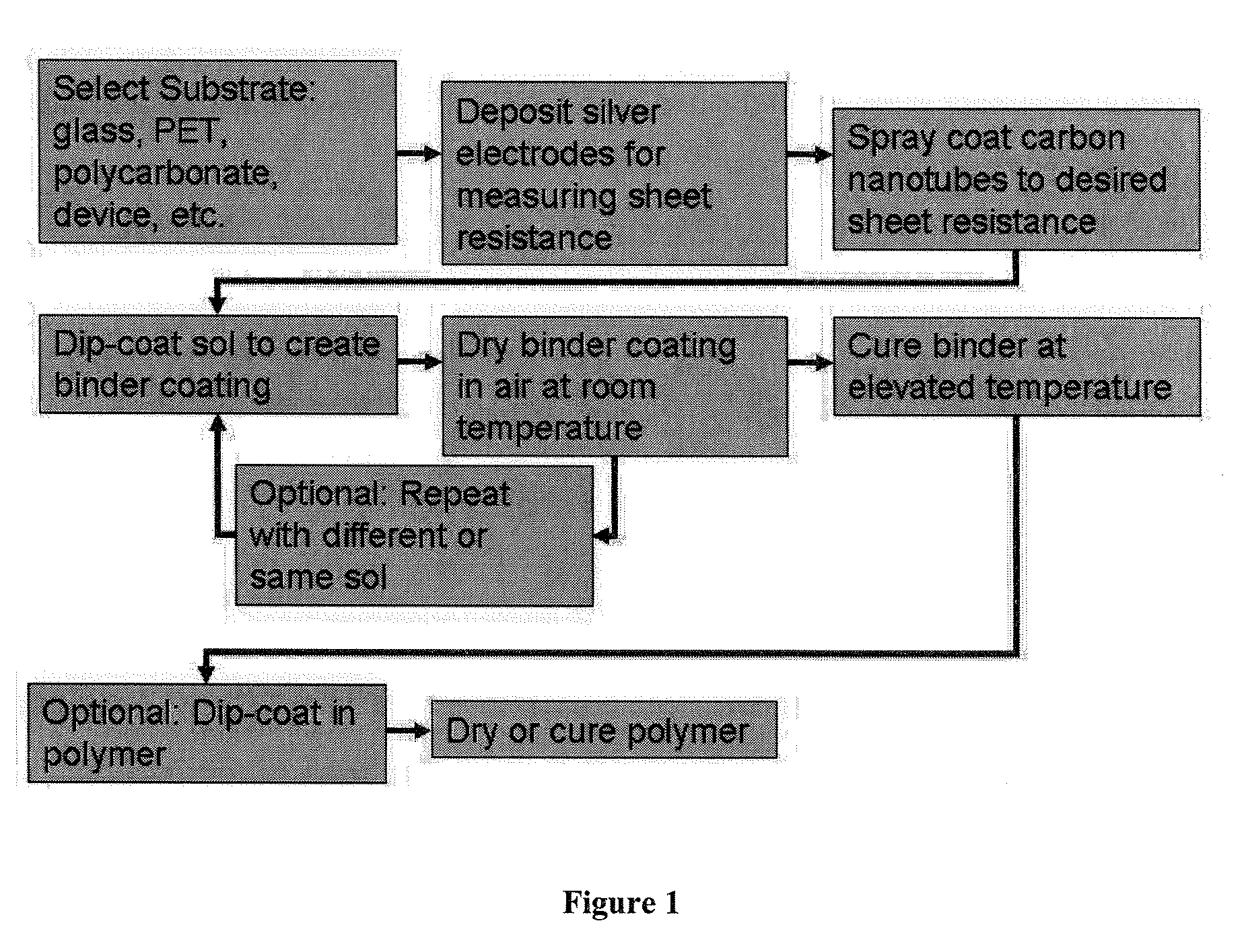Metal oxide coatings for electrically conductive carbon nanotube films
a technology of carbon nanotubes and metal oxide coatings, which is applied in the direction of natural mineral layered products, synthetic resin layered products, transportation and packaging, etc., can solve the problems of brittle ito films, difficult and expensive scaling up of both processes to cover large areas, and high cost, so as to prevent the degradation of composite materials
- Summary
- Abstract
- Description
- Claims
- Application Information
AI Technical Summary
Benefits of technology
Problems solved by technology
Method used
Image
Examples
example 1
ZnO Binder
[0084]To make a 3.7% weight zinc alkoxide sol, 46.82 grams of 2-Propanol were added into a 250 ml container. Next, 1.7947 grams of Zinc Methoxyethoxide (Gelest) was weighed into the same container. Concentrated Hydrochloric Acid was slowly added to the container until 1.3853 grams were added. A sonication bath is preferably used to dissolve the Zinc Methoxyethoxide. Care should be taken to not overshoot the amount of acid added as this may affect the properties the final coating. The solution should be stored in a tight sealing container to prevent moisture from entering the container and prevent evaporation of the 2-propanol. For larger batches, the ratio of reagents is listed in Table 1: Weights of reagents for producing Zn alkoxide sol of different quantity.
TABLE 1Weights of reagents for producing Zn alkoxide sol of different quantityCompoundFactor50 Grams100 Grams1000 GramsIPA0.936446.820093.64936.40Zinc0.0358951.79473.589535.8948MethoxyethoxideHCl0.0277051.38532.77052...
example 2
TiO2—ZnO Binder
[0089]Glass slides coated with CNT were dip coated in 10.2% Ti butoxide sol (2 dips, at a speed of 3.33 inch / min), dried in air, and then dipped (4 dips, speed 4.07 inch / min) in 2.2% zinc alkoxide sol. The samples were then placed in the oven at 120 degrees C. for 2.5 hours. Controls of CNT on glass with no binder were placed in the oven under the same conditions. Samples were heat tested and measured as described above. Samples were placed in an oven at 80 degrees C. for heat testing. Sheet resistance of samples was measured after spraying, after curing the binder, at 24, 48, 72, 96, 144, and 260 hours. The data are listed in Table 4: Resistance of samples with Ti—Zn oxide binder during heating at 80 deg C. for up to 260 hours, compared to controls (Cont) of uncoated CNT layers:
TABLE 4Resistance of samples with Ti—Zn oxide binder during heating at 80 degC. for up to 260 hours, compared to controls (Cont) of uncoated CNT layersSprayedBinderSampleCNT / RR startR / 24R / 48R / ...
example 3
Al2O3—ZnO Binder
[0091]A solution of aluminum alkoxide was used for forming of Al2O3 binder. 10 g of aluminum butoxide were weighed out and put in a container. 90 g of absolute IPA were weighed out in the same container. Solution was mixed for 15 minutes for dissolving of alkoxide. The prepared transparent solution was stabilized by adding concentrated Hydrochloric Acid. The acid was added slowly drop-wise. A sonication bath is optionally used to help dissolve any solid deposit. See Table 6: Weights of reagents for producing Al alkoxide sol of different quantity for ratios of different batch sizes:
TABLE 6Weights of reagents for producing Al alkoxide sol of different quantityCompoundFactor50 Grams100 Grams1000 GramsIPA0.904590900Aluminum0.10510100ButoxideHCl0.010.5110
[0092]Glass slides coated with CNT were dip coated in 10% Al butoxide sol (3 dips, speed 3.3 inch / min), dried in air, and then dipped in 2.2% zinc alkoxide sol (4 dips, speed 2.57 inch / min). The samples were then placed i...
PUM
| Property | Measurement | Unit |
|---|---|---|
| temperatures | aaaaa | aaaaa |
| thickness | aaaaa | aaaaa |
| thickness | aaaaa | aaaaa |
Abstract
Description
Claims
Application Information
 Login to View More
Login to View More - R&D Engineer
- R&D Manager
- IP Professional
- Industry Leading Data Capabilities
- Powerful AI technology
- Patent DNA Extraction
Browse by: Latest US Patents, China's latest patents, Technical Efficacy Thesaurus, Application Domain, Technology Topic, Popular Technical Reports.
© 2024 PatSnap. All rights reserved.Legal|Privacy policy|Modern Slavery Act Transparency Statement|Sitemap|About US| Contact US: help@patsnap.com










